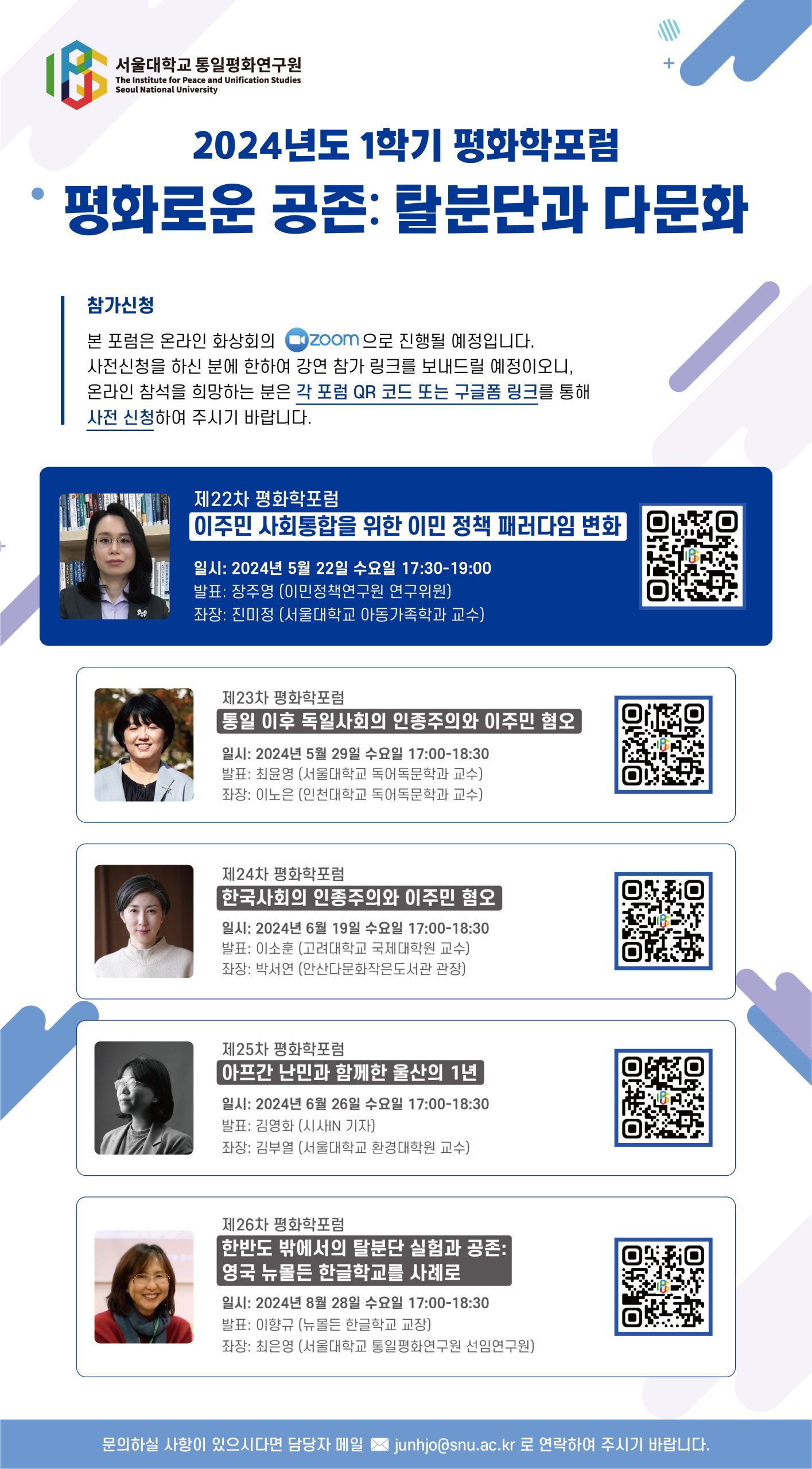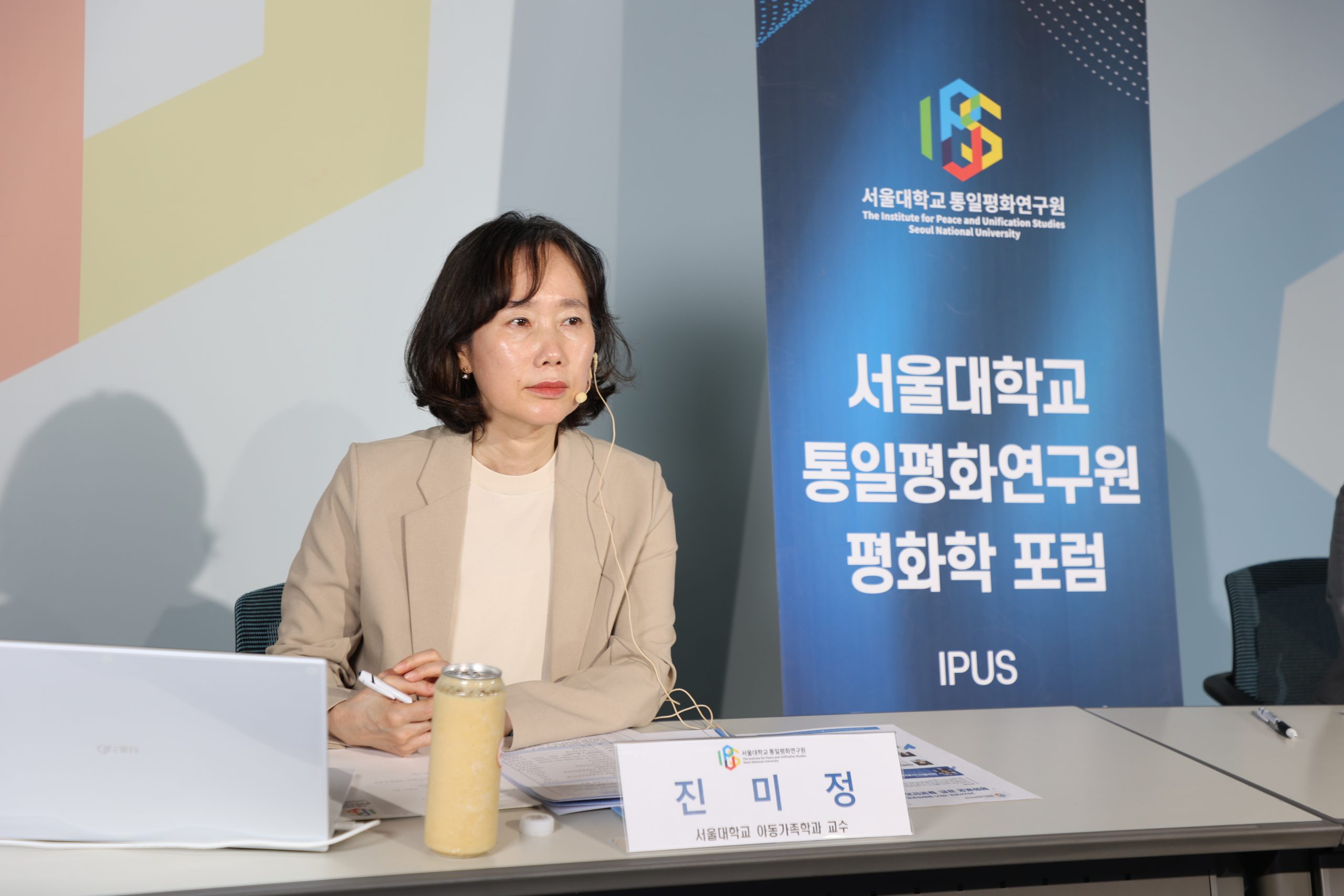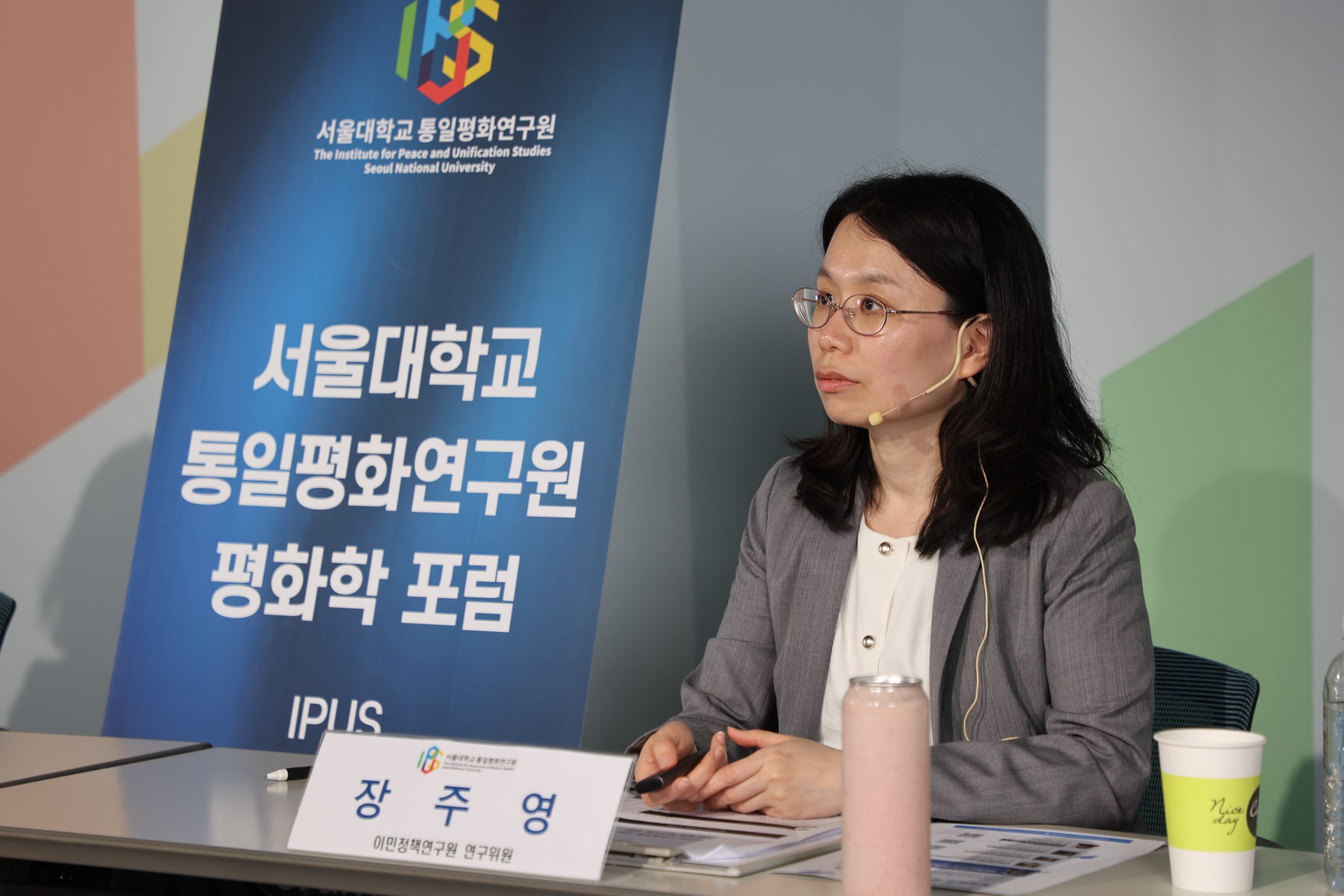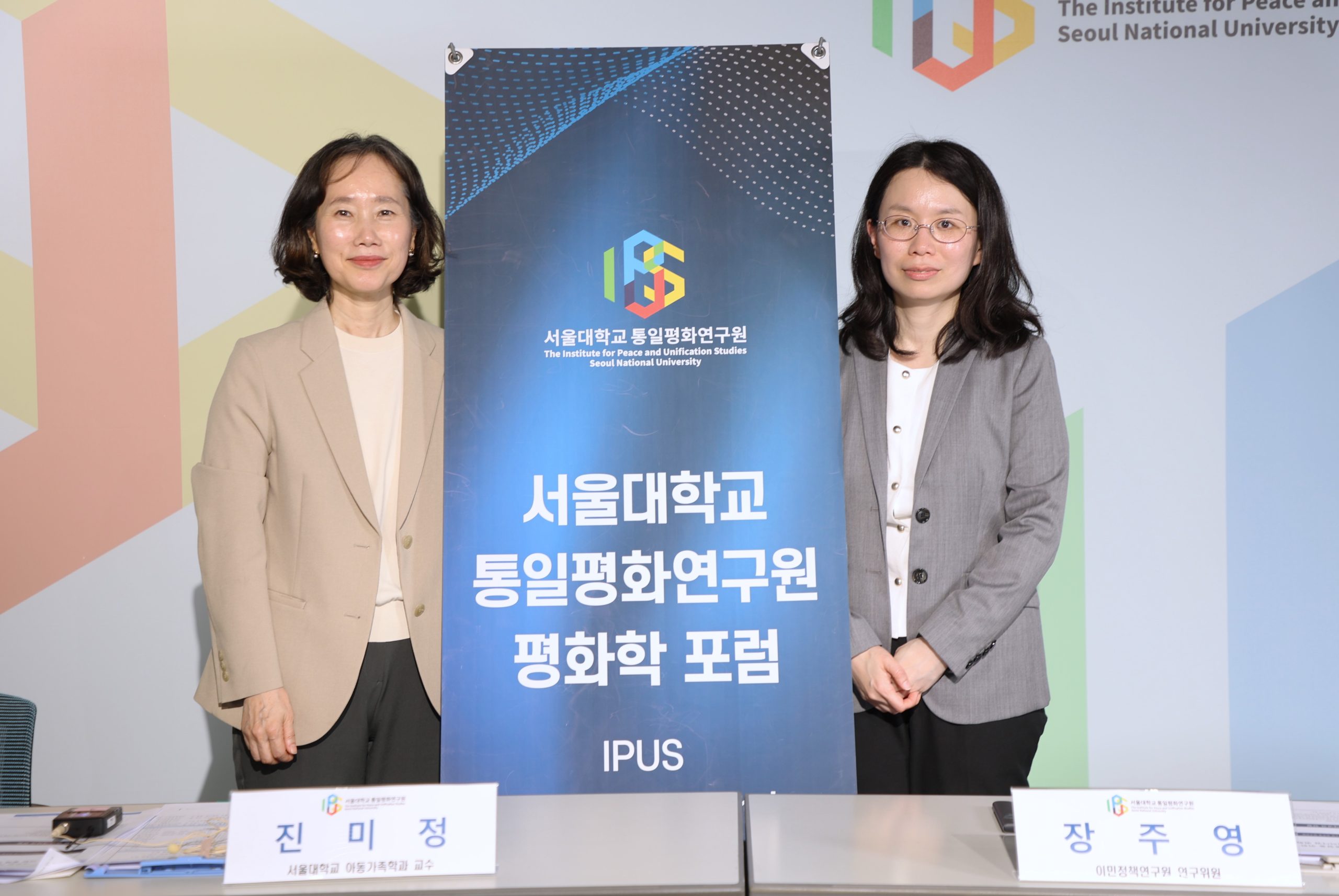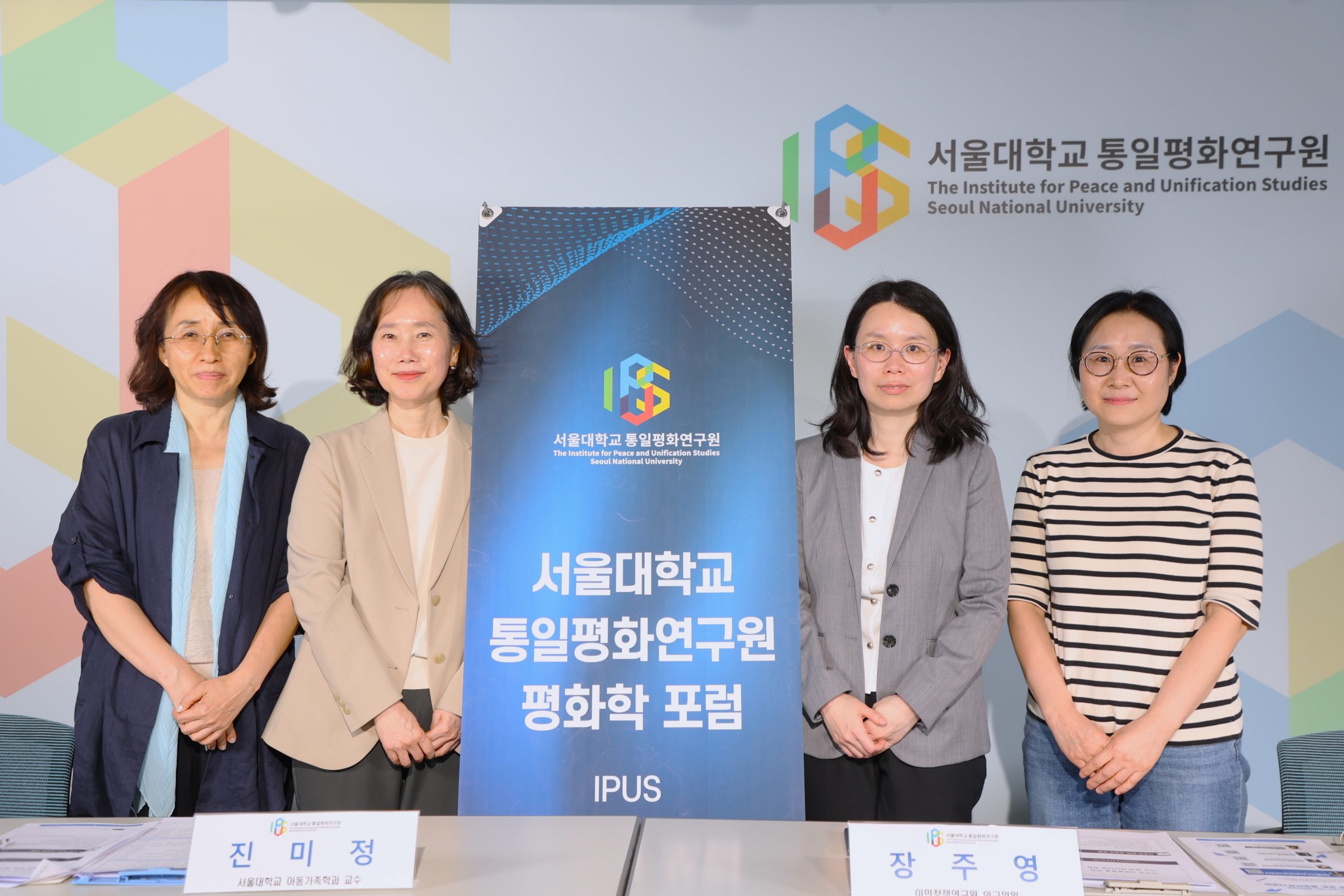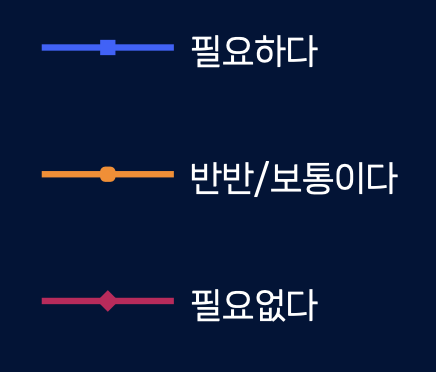[22nd Peace Studies Forum] Paradigm Shift in Immigration Policy for Migrant Integration
- Date: Wednesday, May 22, 2024, 17:30-19:00
- Venue: Online Video Conference (ZOOM)
- Presenter: Jang, Juyoung (Research Fellow, Migration Research and Training Centre)
- Chair: Chin, Meejung (Professor, Dept. of Child Development and Family Studies at Seoul National University)
- Theme: Paradigm Shift in Immigration Policy for Migrant Integration
The Institute for Peace and Unification Studies at Seoul National University (IPUS at SNU) held the 22nd Peace Studies Forum on Wednesday, May 22, 2024, under the overarching theme of ‘Peaceful Coexistence: Post-Division and Multiculturalism.’ The forum featured a discussion led by Research Fellow Jang Juyoung from the Migration Research and Training Centre under the main topic ‘Paradigm sight in Immigration Policy for Migrant Integration.’ Professor Chin Meejung from the Department of Child Development and Family Studies at Seoul National University chaired the forum, introducing the agenda for the upcoming Peace Studies Fora before delivering welcoming remarks and officially opening the event.
In this forum, Dr. Jang aimed to review the changes and current status of Korea’s immigration policies and explore the direction of immigration policy necessary for social integration. First, Dr. Jang introduced various concepts of migrants based on statistics compiled by the Ministry of Justice and the Ministry of the Interior and Safety to explain the scale of migrants in Korea. “The number of ‘foreigners legally residing in Korea with long-term visa’ announced by the Ministry of Justice is about 1.69 million, accounting for 3.3% of the total population, as of 2022,” Dr. Jang said, and “which is a significant increase compared to 1998, when it was about 150,000, accounting for 0.3% of the total population.” “The ‘foreign residents’ cited in the Ministry of the Interior and Safety’s statistics are estimated to be about 2.26 million as of 2022, accounting for 4.4% of the total population,” she explained, “and the reason for the discrepancy with the Ministry of Justice’s statistics is that the Ministry of the Interior and Safety’s statistics include Koreans who are not foreigners.” “Since the number of undocumented stateless persons of foreign origin born in Korea is not counted, no one knows the exact number of immigrants living in Korea,” Dr. Jang continued, “but nevertheless, the number of foreigners living in Korea who are long-term residents continues to increase.” Specifically, “the origin of migrants is diversifying and the difference in gender and age structure between urban and rural areas is changing compared to the past,” Dr. Jang said, noting that “one of the most notable phenomena is the increasing number of children and adolescents with migrant backgrounds in schools.”
Dr. Jang went on to explain the changing concept of migrant integration, highlighting the lack of an agreed concept of ‘migrant integration’ in a world where the number and diversity of migrants are increasing. In particular, she introduced a paper by Spencer & Charlsey (2021), which states that “despite the shift in the existing debate from ‘assimilation’ to ‘integration’, there are increasing criticisms of the concept, objectives, and measurement of migrant integration.” She explained that “there are criticisms that the focus on the justification and desirable goals of integration, rather than the process of integration, problematizes ‘migrants as the only others in need of integration’ and assumes a society as a unified ideal structure.” Moving further from the concept of acculturation, which refers to “changes in values, attitudes, behaviors, and identities as a result of the relationship between migrants and natives,” Dr. Jang drew attention to Spencer and Charlsey’s (2021) concept of integration as a process, which they describe as “a multidirectional, spatial, transnational, and temporary process of individual and social change in structural, social, cultural, and civic spheres and identities. Dr. Jang noted the author’s explanation that “the antonym of integration is not ‘disintegration’ but ‘the absence of interaction or the process of individual and social change,’” and emphasized that “this will have great significance for Korean society.”
Dr. Jang went on to explain the decision-making process of immigration and integration policies by explaining the model of ‘combining immigration integration policies with interactive acculturation strategies’ proposed by Bourhis et al. (1997), and introduced the evolution of Korea’s migrant integration policies, starting with the 1991 Industrial Training Program and the Ministry of Health and Social Affairs’ “Project for Marriage between Rural Bachelors and Korean Chinese Women,” and the ratification and entry into force of the Refugee Convention in 1993. Dr. Jang emphasized the lack of an explicit definition of migrant ‘integration’ as in other countries, and introduced the vision and policy goals of the ‘Master Plan for Immigration Policy,’ Korea’s flagship migrant integration policy launched in 2008. Specifically, Dr. Jang noted that “it is noteworthy that the vision of the first through fourth ‘Master Plan for Immigration Policy’ focuses only on ‘conforming to global standards,’” and that “the actual policies for social integration within the policy goals have not changed significantly.”
Dr. Jang then assessed the direction of Korea’s migrant integration policies, noting that “there are many policies in place that raise questions about whether migrants are viewed on an equal footing.” In particular, “discrimination and exclusion of migrants in social services is noticeable,” she said, citing the issue of equal pay for migrant domestic workers as the most contentious issue, and pointing out that “confusion exists regarding the prioritization criteria for migrants’ membership in society.” In particular, She highlighted national health insurance as the most visible area of discrimination, noting that “the lack of protection for children and adolescents with migrant backgrounds”, and that there is a “lack of consistency” regarding “restrictions and permissions on inviting migrant family members.”
Finally, Dr. Jang emphasized that “what we need to talk about at this point is a paradigm shift toward integration of natives and immigrants,” citing recent statistics showing that more respondents believe that “at a certain point in time, foreigners should be able to receive the same welfare benefits as Koreans,” and fewer respondents believe that “immigrants should be reduced.” Specifically, Dr. Jang stressed that “we need to shift the narrative from ‘multiculturalism’ to ‘diversity’ and gradually expand the scope of social services for migrants to prevent their vulnerability by emphasizing their residency at the community level where they actually live.” “We need to change the direction to respect the autonomy of migrants instead of emphasizing assimilation only,” she said, “and build a sustainable social integration paradigm by establishing policy communication strategies centered on alternative discourses and promoting ‘social integration as a process’ and attempting to improve the trials and errors that occur along the way.

